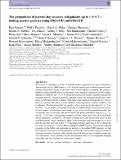The progenitors of present-day massive red galaxies up to z ap 0.7 - finding passive galaxies using SDSS-I/II and SDSS-III
Abstract
We present a comprehensive study of 250 000 galaxies targeted by the Baryon Oscillation Spectroscopic Survey (BOSS) up to z≈ 0.7 with the specific goal of identifying and characterizing a population of galaxies that has evolved without significant merging. We compute a likelihood that each BOSS galaxy is a progenitor of the luminous red galaxies (LRGs) sample, targeted by SDSS-I/II up z≈ 0.5, by using the fossil record of LRGs and their inferred star formation histories, metallicity histories and dust content. We determine merger rates, luminosity growth rates and the evolution of the large-scale clustering between the two surveys, and we investigate the effect of using different stellar population synthesis models in our conclusions. We demonstrate that our sample is slowly evolving (of the order of 2 ± 1.5 per cent Gyr−1 by merging) by computing the change in weighted luminosity-per-galaxy between the two samples, and that this result is robust to our choice of stellar population models. Our conclusions refer to the bright and massive end of the galaxy population, with Mi0.55≲−22 and M*≳ 1011.2 M⊙, corresponding roughly to 95 and 40 per cent of the LRGs and BOSS galaxy populations, respectively. Our analysis further shows that any possible excess of flux in BOSS galaxies, when compared to LRGs, from potentially unresolved targets at z≈ 0.55 must be less than 1 per cent in the r0.55 band (approximately equivalent to the g band in the rest frame of galaxies at z= 0.55). When weighting the BOSS galaxies based on the predicted properties of the LRGs, and restricting the analysis to the reddest BOSS galaxies, we find an evolution of the large-scale clustering that is consistent with dynamical passive evolution, assuming a standard cosmology. We conclude that our likelihoods give a weighted sample that is as clean and as close to passive evolution (in dynamical terms, i.e. no or negligible merging) as possible, and that is optimal for cosmological studies.
Citation
Tojeiro , R , Percival , W J , Wake , D A , Maraston , C , Skibba , R A , Zehavi , I , Ross , A J , Brinkmann , J , Conroy , C , Guo , H , Manera , M , Masters , K L , Pforr , J , Samushia , L , Schneider , D P , Thomas , D , Weaver , B A , Bizyaev , D , Brewington , H , Malanushenko , E , Malanushenko , V , Oravetz , D , Pan , K , Shelden , A , Simmons , A & Snedden , S 2012 , ' The progenitors of present-day massive red galaxies up to z ap 0.7 - finding passive galaxies using SDSS-I/II and SDSS-III ' , Monthly Notices of the Royal Astronomical Society , vol. 424 , no. 1 , pp. 136-156 . https://doi.org/10.1111/j.1365-2966.2012.21177.x
Publication
Monthly Notices of the Royal Astronomical Society
Status
Peer reviewed
ISSN
0035-8711Type
Journal article
Rights
© 2012 The Authors, Monthly Notices of the Royal Astronomical Society © 2012 RAS. This work has been made available online in accordance with the publisher’s policies. This is the final published version of the work, which was originally published at https://doi.org/10.1111/j.1365-2966.2012.21177.x
Items in the St Andrews Research Repository are protected by copyright, with all rights reserved, unless otherwise indicated.

